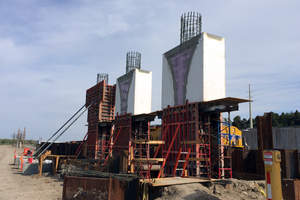DENVER, CO--(Marketwired - Mar 1, 2016) - The Cheyenne South Valley Connector is composed of a mile of new two-lane roadway that will connect the east and west sides of Pocatello, Idaho. The main feature is a 430-foot long bridge traversing the Portneuf River, six active railroad tracks, South 2nd Avenue in Pocatello and several bike and pedestrian paths. On a community-impact project, finding ways to streamline construction and minimize disruptions to local activities is paramount. Contractor W.W. Clyde's efforts were led by project manager Bryson Clyde, a licensed Professional Engineer.
"In almost every project cost, schedule, and resources are the three primary variables and it's my responsibility to balance the allocation of each, which often requires some innovative thinking," remarked Clyde.
On the Cheyenne South Valley Connector, innovation came in the form of an unusual application of ACH Foam Technologies' Foam-Control EPS Geofoam. An engineered lightweight material made of expanded polystyrene (EPS) foam with high compressive strengths and predictable material performance, Foam-Control EPS Geofoam is frequently used as a structural-fill on roadway and embankment projects. In the case of the project's large bridge the Geofoam was used to create the form work for the bridge's three concrete piers.
Typically, builders use wood or metal form work, which in custom applications like the bridge can be time consuming and expensive. Clyde calculated that using Geofoam as formwork saved the project an estimated $7,800 in material costs alone. Add a projected 200 man hours saved by not having to build wooden forms by hand.
W.W. Clyde worked closely with ACH Foam Technologies' engineering department to develop drawings for the form work, which required state approval before being used. Once the drawings were approved, foam blocks were cut to the engineering specifications of the pier radiuses. Curved fillets were attached to the foam blocks to create the finished concrete's fluted surfaces, adding a smooth, aesthetic flair to the final surface. The foam blocks were delivered to the site, secured in place, and the concrete was poured from the top to fill the carefully constructed void of each pier.
"Using ACH Foam Technologies' Foam-Control EPS Geofoam saved money and a lot of time," finished Clyde. "We shaved more than a week off of a tight schedule by using EPS Geofoam as form work. When it arrived on site, putting it in place was quite easy and things were very efficient."
